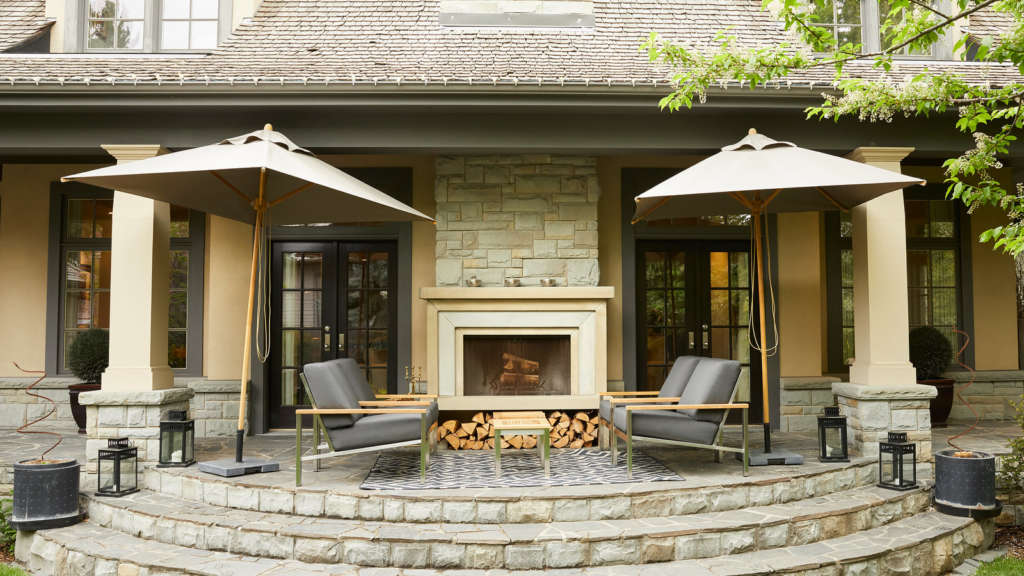New York- This two-story, stone-and-stucco house is in the established Elbow Park neighborhood of Calgary, the largest city in Alberta Province, Canada, with a population of 1.4 million. A short drive from downtown, it sits on more than a quarter of an acre, at the end of a quiet cul-de-sac near the scenic Elbow River.
The house is nearly 4,000 square feet, with three bedrooms and three full and two partial bathrooms, as well as a finished basement and a three-car attached garage. A separate carriage house, converted from a horse barn built in the early 1900s, could be used as guest or staff quarters.
“There are few properties in the area that have a carriage house,” said one of the listing agents, Dennis J. Plintz, of Sotheby’s International Realty Canada. “And the lot size is two or three times larger than most other homes in the community.”
The house was built in 2005 in a traditional style, with a long slate walkway snaking up to a large wooden front door and stone porch. Inside, the style is more contemporary, with recessed lighting and hardwood floors throughout.
On one side of the central tiled foyer is a formal living-and-dining area with a fireplace and oversize front-facing window. On the other is a great room with another fireplace, a coffered ceiling and three sets of French doors that open to a landscaped yard with a stone patio, a built-in barbecue and an outdoor fireplace. The great room also contains a library and casual dining area; beyond that is an open chef’s kitchen equipped with stainless-steel appliances, wood cabinets, a butler’s pantry and a central island with seating. A laundry room and a half-bath are on the first level as well.
A grand staircase leads upstairs from the foyer to three en-suite bedrooms. The master suite has a spalike bath, a seating area, a large dressing room and a Juliet balcony facing the front yard.
There is additional living space in the finished basement and carriage house: The basement has a family room with a fireplace and a workout area with a sauna; the carriage house features an open living area, loft space and a bathroom.
The Elbow Park neighborhood, in the southwest quadrant of Calgary, is one of the city’s oldest and wealthiest communities, home to many executives of the oil and gas companies in the area, Mr. Plintz said. Calgary International Airport is about 15 miles away, and ski resorts in the Canadian Rockies are less than a two-hour drive.
MARKET OVERVIEW
The Calgary housing market was more or less unscathed by the 2008 financial crisis, Mr. Plintz said. “When North America crashed, we did not and continued to grow through the next few years.”
But in the past couple of years, Calgary has had its worst recession in decades, precipitated by weakness in the oil and gas industry, and the housing market is still recovering. The luxury market was hit especially hard, as companies downsized and unemployment levels rose. “This would have been a five-million-dollar house at one point just a few years ago,” Mr. Plintz said of his listing.
There have been signs of late that Calgary’s housing market, and luxury in particular, is slowly coming back. Sales volume has risen as sellers have lowered their expectations on prices, agents said, and buyers on the sidelines have re-entered the market.
“We were in limbo last year,” said Stewart J. Lowe, an agent for Calgary Dream Homes. “But things really started moving significantly in the last month. We’ve had some multiple offers, and the higher end is moving again.”
WHO BUYS IN CALGARY
Most buyers in Elbow Park are locals, real estate agents said. But Calgary, in general, draws a number of foreign buyers, including Americans.
Since the recession, the city has seen a slowdown in foreign purchases, agents said. Lately, though, there has been increased interest from Asian buyers, particularly those from Hong Kong and China, who find the area appealing because it is less expensive than neighboring British Columbia Province, Mr. Lowe said: “Over the last 12 months, the Chinese have been looking hard at Calgary.”
BUYING BASICS
Although international home buyers generally face no restrictions, each Canadian province has its own set of rules and fees. “Every province is in charge of its own real estate transactions,” said John E. Fletcher, a real estate lawyer based in Calgary. “We’re like 10 little countries in one big country, when it comes to real estate.”
In Alberta, he said, buyers are required to pay land title and mortgage registration fees, which are on a sliding scale based on the purchase price of a property and the loan amount.
Transactions are done in Canadian dollars. Financing is often available from local lenders, though nonresident borrowers will likely be required to make larger down payments. Nonresidents (and sometimes Canadians residing in another country) may also face a withholding tax on the capital gains when it comes time to sell their property, said Farouk Shivji, another Calgary real estate lawyer.
LANGUAGES AND CURRENCY
English, French; dollar (1 Canadian dollar = $0.74)
TAXES AND FEES
The seller usually pays the sales commission, which varies by brokerage firm. For this house, according to the listing information, it is a total of 7 percent on the first $100,000 of the sale price and 3 percent on the balance
Most of the closing costs are paid by the buyer, including legal expenses, typically averaging $1,000 to $1,500, and provincial fees.
The annual property taxes on this house are around $16,500, Mr. Plintz said.
